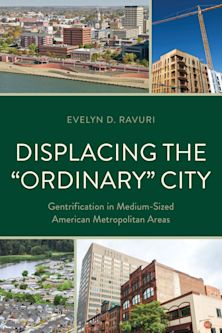- Home
- ACADEMIC
- Geography
- Human Geography
- Trains, Culture, and Mobility
Trains, Culture, and Mobility
Riding the Rails
Benjamin Fraser (Anthology Editor) , Steven D. Spalding (Anthology Editor) , Samuel Gerald Collins (Contributor) , Colin Divall (Contributor) , Tristan R. Grunow (Contributor) , Araceli Masterson-Algar (Contributor) , Alexander Medcalf (Contributor) , Agata Morka (Contributor) , Hiraku Shimoda (Contributor) , Hiroki Shin (Contributor) , Peter Soppelsa (Contributor) , Rowan Wilken (Contributor)
Trains, Culture, and Mobility
Riding the Rails
Benjamin Fraser (Anthology Editor) , Steven D. Spalding (Anthology Editor) , Samuel Gerald Collins (Contributor) , Colin Divall (Contributor) , Tristan R. Grunow (Contributor) , Araceli Masterson-Algar (Contributor) , Alexander Medcalf (Contributor) , Agata Morka (Contributor) , Hiraku Shimoda (Contributor) , Hiroki Shin (Contributor) , Peter Soppelsa (Contributor) , Rowan Wilken (Contributor)
You must sign in to add this item to your wishlist. Please sign in or create an account
Description
Trains, Culture and Mobility: Riding the Rails goes beyond textual representations of rail travel to engage an impressive range of political, sociological and urban theory. Taken together, these essays highlight the complexity of the modern experience of train mobility, and its salient relation to a number of cultural discourses. Incorporating traditionally marginal areas of cultural production such as graffiti, museums, architecture or even plunging into the social experience of travel inside the traincar itself, each essay constitutes an attempt to work from the act of riding the train toward questions of much larger significance. Crisscrossing cultures from the New World and Old, from East and West, these essays share a common preoccupation with the way in which trains and railway networks have mapped and re-mapped the contours of both cities and states in the modern period. Bringing together individual and large-scale social practices, this volume traces out the cultural implications of “Riding the Rails.”
Table of Contents
Benjamin Fraser and Steven D. Spalding
Part I. Speed and Vision
Chapter 1: Cultures of Speed and Conservative Modernity: Representations of Speed in Britain’s Railway Marketing
Colin Divall & Hiroki Shin
Chapter 2: The Speed of Signs: Train Graffiti, Cultural Production and the Mobility of the Urban in France and Spain
Benjamin Fraser and Steven D. Spalding
Part II. On Passengers
Chapter 3: ‘What to Wear and Where to Go’: Picturing the Modern Consumer on the Great Western Railway 1921-39
Alexander Medcalf
Chapter 4: Seen from a Carriage: A Rhythmanalytic Study of Train Travel and Mediation
Rowan Wilken
Part III. City Networks
Chapter 5: Urban Railways, Industrial Infrastructure and the Paris Cityscape, 1870-1914
Peter Soppelsa
Chapter 6: Subways and Cell Phones: Seoul as a Network City
Samuel Gerald Collins
Part IV. Inside the Station
Chapter 7: Brief Encounters and Lasting Impressions: Contemporary Train Station Architecture
Agata Morka
Chapter 8: Digging Madrid: A Descent into Madrid’s Subway Museum, ‘Andén 0 [Platform] 0’
Araceli Masterson-Algar
Part V. Shifting States
Chapter 9: Trains, Modernity, and State-Formation in Meiji Japan
Tristan R. Grunow
Chapter 10: ‘The Super-Express of Our Dreams’ and Other Mythologies about Postwar Japan
Hiraku Shimoda
Notes on Contributors
Index
Product details
| Published | Dec 29 2011 |
|---|---|
| Format | Ebook (Epub & Mobi) |
| Edition | 1st |
| Extent | 308 |
| ISBN | 9780739167502 |
| Imprint | Lexington Books |
| Publisher | Bloomsbury Publishing |
About the contributors
Reviews
-
Trains, Culture and Mobility: Riding the Rails is an exemplary piece of interdisciplinary scholarship which shows the value of a cultural theory grounded in the particularities of cultural history. Incorporating the study of photography, architecture, publicity material and everyday practices and phenomena, it manages to be extremely broad-ranging in its geographical and thematic scope while retaining an unusual level of coherence for an edited collection. It is also pleasingly quirky and distinctive in its concerns, from train graffiti to cell phone etiquette.
Joe Moran, Liverpool John Moores University, UK


































